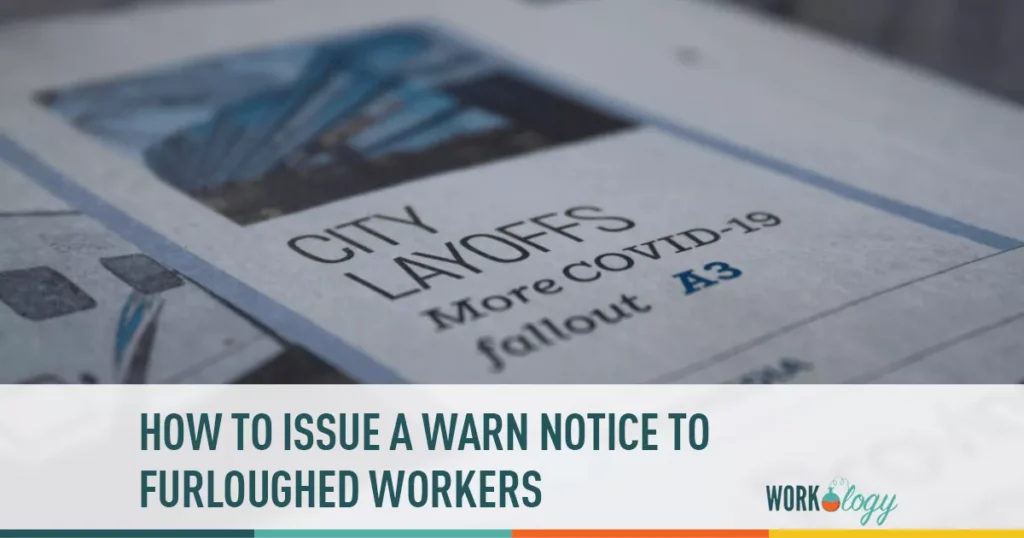In response to the COVID-19 (coronavirus) pandemic, many companies – including hotels, restaurants, major retail chains, and manufacturers, have had to reduce hours, pay or close sites and furlough employees. For many employers, these layoffs are expected to be temporary while the virus runs its course, a period estimated by the current administration to end in July or August 2020. But a lot can happen during that time, including the possibility of an economic recession.
What is the WARN Act?
Furloughs or brief layoffs may become an event that necessitates notice requirements under the federal Worker Adjustment and Retraining Notification (WARN) Act during a recession. The Worker Adjustment and Retraining Notification Act of 1988 (the “WARN Act”) is a US labor law that mandates that most employers with 100 or more employees must give 60 calendar days’ notice before closing a plant or mass-firing employees, as defined by the Act. This law’s goal is to protect workers, their families, and communities. In 1989, it went into force after being a law in August 1988.
Employees entitled to notice under the WARN Act include managers and supervisors, hourly wage, and salaried workers. The advance notice is intended to give workers and their families transition time to adjust to the prospective loss of employment, to seek and to obtain other employment, and, if necessary, to enter skill training or retraining programs that will allow these workers to successfully compete in the job market.
How to Issue WARN Notices to Employees During COVID-19
My main worry for businesses is that the archaic habit of mailing a postcard or a certified letter doesn’t make sense if we don’t have our employees’ updated personal information. While they are on furlough, employees should be contacted to change their mailing address, phone number, and personal email address so that we have this information and can get in touch with them no matter what we decide to do next.
My primary concern for businesses is that if we don’t have our employees’ most recent personal information, the antiquated practice of delivering a postcard or a certified letter doesn’t make sense. Employees should be contacted to update their mailing address, personal phone number, and email address while they are on furlough so that we have this information and can reach them regardless of what we decide to do next.
Any appropriate means of delivery that ensures the written notice is received at least 60 days prior to separation may be used by the employer. However, verbal notices and preprinted notices that are routinely inserted into each employee’s paycheck or pay envelope do not adhere to the WARN Act’s provisions. Each impacted employee must get a distinct copy of the WARN notification, which takes effect the day after it is received and not the day it was sent. Workers must receive notice at least 60 days before separation. According to the Department of Labor, this does not mean that if one or two notices are not delivered through no fault of the employer, there is a violation. It is prudent, however, to make sure that the workers who were sent notices actually got them.
Can We Send a WARN Notice by Email?
Employers may issue WARN notices via email, although the same requirements for the content of the notices remain in place. Given the COVID-19 pandemic related guidelines and orders issued by many states, email may be a preferred method of notifying State and local government personnel, since many State officials are working from home. Employers are encouraged to reach out to these offices for more information on the preferred method of delivery.
According to the Electronic Code of Federal Regulations, (20 CFR 639.7), notice to each affected employee (who does not have a union representative) is to be written in language understandable to the employees and must contain:
– A statement as to whether the planned action is expected to be permanent or temporary and, if the entire plant is to be closed, a statement to that effect;
– The expected date when the plant closing or mass layoff will commence and the expected date when the individual employee will be separated;
– An indication whether or not bumping rights (a contractual privilege granted to a more senior employee, allowing them to replace a less senior employee) exist;
– The name and telephone number of a company official to contact for further information.
It’s important to note that state law, union agreements and employer policies may provide employees with greater rights than are provided by WARN. The mini-WARN Acts may have different thresholds to be considered a covered employer or to have a covered event. For example, both New York and New Jersey require 90 days of notice before a layoff, with a threshold of only 25 job losses. The California WARN (Cal-WARN) Act applies to establishments at which at least 75 employees had been employed during the prior year, and requires employers to provide at least 60 days’ advance notice of a mass layoff, relocation or termination.
The U.S. Department of Labor does not require employers to provide WARN notices to the Department. However, employers are required to provide WARN notices to the state dislocated worker unit. Some states publish WARN notice listings on their websites but this is voluntary for states, so the frequency of listings and amount of information varies from state to state. The DOL recommends reaching out to each state for information. A list of State Rapid Response Coordinators and contact information is on the DOL website here.









